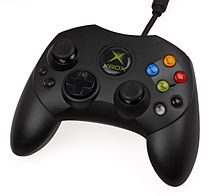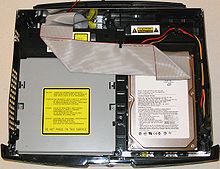- Xbox
-
This article is about sixth generation games console, released in 2001. For its successor, see Xbox 360. For other uses, see Xbox (disambiguation).
Xbox 

Xbox console with "Controller S"Manufacturer Microsoft Product family Xbox Type Video game console Generation Sixth generation Retail availability - NA November 15, 2001
- JP February 22, 2002
- PAL March 14, 2002
Discontinued - JP 2005
- NA 2008
- EU 2005
Units sold 24+ million (as of May 10, 2006)[1] Media DVD, CD, Download Operating system Custom (Based on Windows NT architecture and Windows XP (through Xbox LIVE)) CPU Custom 733 MHz Intel Pentium III "Coppermine-based" processor Storage capacity 8 or 10 GB internal Hard Drive (Formatted to 8 GB with alloted system reserve and MS Dash), 8 MB memory card Memory 64 MB of DDR SDRAM @ 200 MHz Graphics 233 MHz nVidia NV2A Controller input 4× Xbox controller ports (proprietary USB interface) Connectivity 100 Mbit Ethernet Online services Xbox Live Best-selling game Halo 2, 8 million (as of May 9, 2006)[2][3] Successor Xbox 360 The Xbox is a sixth-generation video game console manufactured by Microsoft. It was released on November 15, 2001 in North America, February 22, 2002 in Japan, and March 14, 2002 in Australia and Europe and is the predecessor to the Xbox 360. It was Microsoft's first foray into the gaming console market, and competed with Sony's PlayStation 2, Sega's Dreamcast, and Nintendo's GameCube. The integrated Xbox Live service allowed players to play games online.[4]
The Xbox was discontinued in late 2006, although the final Xbox game, Madden NFL 09 was released in August 2008. Support for out-of-warranty Xbox consoles was discontinued on March 2, 2009; any in-warranty repair now needed will not be undertaken and faulty consoles will be replaced with an Xbox 360 instead. Xbox Live support was discontinued on April 15, 2010.[4]
Contents
History
In 1998 four engineers from Microsoft’s DirectX team, Kevin Bachus, Seamus Blackley, Ted Hase and DirectX team leader Otto Berkes, disassembled some Dell laptop computers to construct a prototype Microsoft Windows-based video game console. The team hoped to create a console to compete with the Sony PlayStation 2, which was luring game developers away from the Windows platform. The team approached Ed Fries, the leader of Microsoft’s game publishing business at the time, and pitched their “DirectX Box” console based on the DirectX graphics technology developed by Berkes’ team. Fries decided to support the team’s idea of creating a Windows DirectX based console.[5][6]
During development, the original DirectX box name was shortened to Xbox. Microsoft’s marketing department did not like the Xbox name, and suggested many alternatives. During focus testing, the Xbox name was left on the list of possible names to demonstrate how unpopular the Xbox name would be with consumers. However, consumer testing revealed that Xbox was preferred by far over the other suggested names and “Xbox” became the official name of the product.[7]
The Xbox was Microsoft's first video game console after collaborating with Sega to port Windows CE to the Dreamcast console. Microsoft repeatedly delayed the console, which was first mentioned publicly in late 1999 during interviews with then-Microsoft CEO Bill Gates. Gates stated that a gaming/multimedia device was essential for multimedia convergence in the new times.[8] When Bill Gates unveiled the Xbox at the Game Developers Conference in 2000, audiences were impressed by the console's technology. At the time of Gates' announcement, Sega's Dreamcast sales were diminishing and Sony's PlayStation 2 was just going on sale in Japan.[9]
Concentrating on making a big splash in Japan, Microsoft delayed its European launch, though Europe later proved to be the more receptive market.[9]
Some of Microsoft's plans proved effective. In preparation for its launch, Microsoft acquired Bungie and used Halo: Combat Evolved as its launch title. At the time, GoldenEye 007 for Nintendo 64 had been one of the few hit FPS games to appear on a console, some of other ones being Perfect Dark and Medal of Honor. Halo: Combat Evolved proved a good application to drive the Xbox's sales.[9] In 2002, Microsoft made the second place slot in consoles sold in North America.
Popular launch games for the console included Dead or Alive 3, Amped: Freestyle Snowboarding, Halo: Combat Evolved, Fuzion Frenzy, Project Gotham Racing and Jet Set Radio Future.
Discontinuation and successor
Main articles: Xbox 360 and List of Xbox games compatible with Xbox 360The Xbox's successor, the Xbox 360, was officially unveiled announced on May 12, 2005 on MTV and released in North America on November 22, 2005. Nvidia ceased production of the Xbox's GPU in August 2005, which marked the end of Xbox production.
When equipped with a removable hard drive add-on, the Xbox 360 supports a limited number of the Xbox's game library through emulation. As the architectures of the Xbox and Xbox 360 are different, software emulation is the only way to enable compatibility without including hardware from the original Xbox. Emulation adds support for anti-aliasing as well as upscaling of the still standard definition image. These emulators are periodically updated to add compatibility for older games and are available free through Xbox Live or as a file download to be burned to a DVD-R from the Xbox web site. These updates are also available monthly as part of the demo disc that comes with each issue of Official Xbox Magazine.
Hardware and accessories
See also: Xbox special limited editionsHardware
The Xbox was the first video game console to feature a built-in hard disk drive, used primarily for storing game saves and content downloaded from Xbox Live. This eliminated the need for separate memory cards (although some older consoles, such as the TurboGrafx-CD, Sega CD and Sega Saturn had featured built-in battery backup memory prior to 2001). An Xbox user could rip music from standard audio CDs to the hard drive, and these songs were used for the custom soundtracks in some games.[10]
The Xbox was the first gaming product to feature Dolby Interactive Content-Encoding Technology, which allows real-time Dolby Digital encoding in game consoles. Previous game consoles could only use Dolby Digital 5.1 during non-interactive "cut scene" playback.[11]
The Xbox is based on commodity PC hardware and is much larger and heavier than its contemporaries. This is largely due to a bulky tray-loading DVD-ROM drive and the standard-size 3.5 inch hard drive. The Xbox has also pioneered safety features, such as breakaway cables for the controllers to prevent the console from being pulled from the surface it rests on.
Several internal hardware revisions have been made in an ongoing battle to discourage modding (hackers continually updated modchip designs in an attempt to defeat them), to cut manufacturing costs, and to make the DVD-ROM drive more reliable (some of the early units' drives gave Disc Reading Errors due to the unreliable Thomson DVD-ROM drives used). Later generation units that used the Thomson TGM-600 DVD-ROM drives and the Philips VAD6011 DVD-ROM drives were still vulnerable to failure that rendered the consoles either unable to read newer discs or caused them to halt the console with an error code usually indicating a PIO/DMA identification failure, respectively. These units were not covered under the extended warranty.
In 2002 Microsoft and Nvidia entered arbitration over a dispute on the pricing of Nvidia's chips for the Xbox.[12] Nvidia's filing with the SEC indicated that Microsoft was seeking a US$13 million discount on shipments for NVIDIA's fiscal year 2002. Microsoft alleged violations of the agreement the two companies entered, sought reduced chipset pricing, and sought to ensure that Nvidia fulfill Microsoft's chipset orders without limits on quantity. The matter was privately settled on February 6, 2003.[13]
Launch-era Xbox gaming units were made in Hungary and the controllers made mostly in Indonesia.
Controllers & Accessories
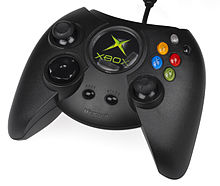 Original "Fatty"[14] Xbox controller
Original "Fatty"[14] Xbox controller
The Xbox controller features two analog sticks, a pressure sensitive directional pad, two analog triggers, a Back button, a Start button, two accessory slots and six 8-bit analog action buttons (A/Green, B/Red, X/Blue, Y/Yellow, and Black and White buttons).[15] The standard Xbox controller (also nicknamed the "Fatty"[14] or the "Duke"[16]) was originally the controller bundled with Xbox systems for all territories except Japan. The controller has been criticized for being bulky compared to other video game controllers; it was awarded "Blunder of the Year" by Game Informer in 2001,[17] a Guinness World Record for the biggest controller in Guinness World Records Gamer's Edition 2008, and was ranked the second worst video game controller ever by IGN editor Craig Harris.[18] The "Controller S" (codenamed "Akebono"), a smaller, lighter Xbox controller, was originally the standard Xbox controller only in Japan,[19] designed for users with smaller hands.[20][21] The "Controller S" was later released in other territories by popular demand and by 2002 replaced the standard controller in the Xbox's retail package, with the larger original controller remaining available as an accessory.
An 8 MB removable solid state memory card can be plugged into the controllers, onto which game saves can either be copied from the hard drive when in the Xbox dashboard's memory manager or saved during a game. Most Xbox game saves can be copied to the memory unit and moved to another console but some Xbox saves are digitally signed; each console has a unique signing key, and some games (e.g. Ninja Gaiden and Dead or Alive Xtreme Beach Volleyball) will not load saved games signed by a different Xbox, limiting the utility of the memory card. Some game saves can be tagged as uncopyable or simply padded to over 8 MB (Star Wars: Knights of the Old Republic). The signing mechanism has been reverse-engineered by the Xbox hacking community, who have developed tools to modify savegames to work in a different console, though the signing key of the recipient Xbox (the "HDkey") and the ramped-up title key of the game (the "authkey") must be known. It is also possible to save an Xbox Live account on a memory unit, to simplify its use on more than one Xbox.
The Xbox includes a standard AV cable which provides composite video and monaural or stereo audio to TVs equipped with RCA inputs. European Xboxes also included an RCA jack to SCART converter block as well as the standard AV cable.
Operating system
The Xbox runs a custom operating system which was once believed to be a modified version of the Windows 2000 kernel. It exposes APIs similar to APIs found in Microsoft Windows, such as DirectX 8.1. The system software may have been based on the Windows NT architecture that powered Windows 2000; it is not a modified version of either.[22]
The user interface for the Xbox is called the Xbox Dashboard. It features a media player that can be used to play music CDs, rip CDs to the Xbox's built-in hard drive and play music that has been ripped to the hard drive; it also let users manage game saves, music, and downloaded content from Xbox LIVE, and lets Xbox LIVE users sign in and manage their account. The dashboard is only available when the user is not watching a movie or playing a game. It uses many shades of green and black for the user interface, to be consistent with the physical Xbox color scheme. When the Xbox was released in 2001 the LIVE service was not online yet, so the dashboard's LIVE feature was unusable.
Xbox LIVE was released in 2002, but in order to access it users had to buy the Xbox LIVE starter kit containing a headset, a subscription, and supplemental. While the Xbox was still being supported by Microsoft, the Xbox Dashboard was updated via Xbox LIVE several times to reduce cheating and add features.
Xbox Live
Main article: Xbox LiveOn November 15, 2002, Microsoft launched its Xbox Live online gaming service, allowing subscribers to play online Xbox games with other subscribers around the world and download new content directly to the system's hard drive. The online service works only with a broadband Internet connection. Approximately 250,000 subscribers signed up within two months of Xbox Live's launch.[23] In July 2004, Microsoft announced that Xbox Live had reached one million subscribers; in July 2005, membership reached two million, and by July 2007 there were more than 3 million subscribers. By May 2009, the number had ballooned to 20 million current subscribers.[24] On February 5, 2010, Marc Whitten posted on gamerscoreblog that Xbox Live support for the original Xbox games would be discontinued as of April 14, 2010.[4] Services were discontinued on schedule, but a group of 20 gamers continued to play for almost a month afterwards by simply leaving their consoles on connected to Halo 2.[25] APACHE N4SIR was the final user to play on the original Xbox's Live Service and was finally disconnected on May 11, 2010 at 01:58 EDT (UTC-4).[26][27]
Games
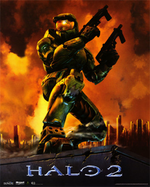 Box cover of Halo 2, Xbox's best selling game
Box cover of Halo 2, Xbox's best selling game Main articles: List of Xbox launch games and List of Xbox games
Main articles: List of Xbox launch games and List of Xbox gamesThe Xbox launched in North America on November 15, 2001. Its most successful launch game was Halo: Combat Evolved.[28] Its sequel, Halo 2, is the best-selling Xbox game worldwide.[3] Although there were several more popular second-party launch titles, including NFL Fever 2002,[29] Project Gotham Racing,[30] and Dead or Alive 3,[31] the early public reputation of the Xbox was damaged by the failure of Azurik: Rise of Perathia and other games designed and marketed by Microsoft.[32]
Although the console gained strong third party support from its inception, many early Xbox games did not fully use its powerful hardware, with few additional features or graphical improvements to distinguish them from the PS2 version, thus negating one of the Xbox's main selling points. Sony countered the Xbox for a short time by temporarily securing PlayStation 2 exclusives for highly anticipated games such as the Grand Theft Auto series and Metal Gear Solid 2: Sons of Liberty.
In 2002 and 2003, several releases helped the Xbox gain momentum and distinguish itself from the PS2. The Xbox Live online service was launched in late 2002 alongside pilot titles MotoGP, MechAssault and Tom Clancy's Ghost Recon. Several best-selling and critically praised titles for the Xbox were published, such as Tom Clancy's Splinter Cell, Ninja Gaiden and LucasArts' Star Wars: Knights of the Old Republic. Take-Two Interactive's exclusivity deal with Sony was amended to allow Grand Theft Auto III and its sequels to be published for the Xbox. Many other publishers got into the trend of releasing the Xbox version alongside the PS2 version, instead of delaying it for months.
In 2004 Halo 2 became the highest-grossing release in entertainment history, making over $125 million in its first day[33] and becoming Xbox Live's first killer app. That year Microsoft made a deal to put Electronic Arts's popular titles on Xbox Live.
The last game released on the Xbox was Madden NFL 09, on August 12, 2008. It was also the only Xbox game released in 2008.[citation needed]
Technical specifications
- CPU: 32-bit 733 MHz, custom Intel Pentium III Coppermine-based processor in a Micro-PGA2 package (though soldered to the mainboard using BGA). 180 nm process.[34]
- SSE floating point SIMD. Four single-precision floating point numbers per clock cycle.
- MMX integer SIMD
- 133 MHz 64-bit GTL+ front-side bus to GPU
- 32 KB L1 cache. 128 KB on-die L2 cache
- Shared memory subsystem
- GPU and system chipset: 233 MHz "NV2A" ASIC. Co-developed by Microsoft and Nvidia.
- Geometry engine: 115 million vertices/second, 125 million particles/second (peak)
- 4 pixel pipelines with 2 texture units each
- 932 megapixels/second (233 MHz × 4 pipelines), 1,864 megatexels/second (932 MP × 2 texture units) (peak)
- Peak triangle performance (32pixel divided from filrate): 29,125,000 32-pixel triangles/s raw or w. 2 textures and lit.
- 485,416 triangles per frame at 60 frame/s
- 970,833 triangles per frame at 30 frame/s
- Peak triangle performance (32pixel divided from filrate): 29,125,000 32-pixel triangles/s raw or w. 2 textures and lit.
- 8 textures per pass, texture compression, full scene anti-aliasing (NV Quincunx, supersampling, multisampling)
- Bilinear, trilinear, and anisotropic texture filtering
- Similar to the GeForce 3 Ti500 PC GPU in performance
- Storage media
- Audio processor: NVIDIA "MCPX" (a.k.a. SoundStorm "NVAPU")
- 64 3D sound channels (up to 256 stereo voices)
- HRTF Sensaura 3D enhancement
- MIDI DLS2 Support
- Monaural, Stereo, Dolby Surround, Dolby Digital Live 5.1, and DTS Surround (DVD movies only) audio output options
- Integrated 10/100BASE-TX wired ethernet
- DVD movie playback (Add-on required)
- A/V outputs: composite video, S-Video, component video, SCART, Digital Optical TOSLINK, and stereo RCA analog audio
- Resolutions: 480i, 480p, 576i, 576p, 720p, 1080i
- Controller ports: 4 proprietary USB 1.1 ports
- Weight: 3.86 kg (8.5 lb)
- Dimensions: 320 × 100 × 260 mm (12.5 × 4 × 10.5 in)[35]
Marketing
Sales
Region Units sold
(as of May 10, 2006)First available North America 16 million November 15, 2001 Europe 6 million March 14, 2002 Asia 2 million February 22, 2002 Worldwide 24 million On November 15, 2001, Xbox launched in North America and quickly sold out.
The Xbox has sold 24 million units worldwide as of May 10, 2006, according to Microsoft.[1] This is divided out to 16 million units sold in North America, six million units in Europe, and two million units sold in Asia.
UK advertising controversy
In 2002 the Independent Television Commission (ITC) banned a television advertisement for the Xbox in the United Kingdom after complaints that it was highly distasteful, violent, scary and upsetting. It depicted a mother giving birth to a small boy who was fired like a projectile through a hospital window and who aged rapidly as he flew through the air yelling. As he soared across a large area, he passed quickly through stages of his life as though time was passing him by. After aging into an old man, he crash-landed into his own grave. Dust and smoke poured from the grave. The advertisement ended with the slogan Life is short. Play more.[36]
Modding
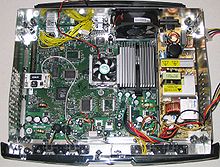 Xbox motherboard, with installed modchip
Xbox motherboard, with installed modchip
The popularity of the Xbox, as well as (in the United States) its comparatively short 90-day warranty, inspired efforts to circumvent the built-in hardware and software security mechanisms, a practice informally known as modding. Within a few months of its release the initial layer of security on the Xbox BIOS (which relied heavily on obfuscation) was broken by MIT student Andrew Huang and the contents of the "hidden" boot ROM embedded on the MCPx chip was extracted using some custom built hardware. Once this information was available, the code was soon modified so that it would skip digital signature checks and media flags, allowing unsigned code, Xbox game backups, etc., to be run. This was possible due to flaws in the Xbox's security.[37] Modding an Xbox in any manner will void its warranty, as it may require disassembly of the console. Having a modified Xbox may also disallow it from accessing Xbox Live, if detected by Microsoft, as it contravenes the Xbox Live Terms of Use,[38] But most modchips can be disabled, allowing the Xbox to boot in a "stock" configuration. Softmods can be disabled by "coldbooting" a game (having the game in the DVD drive before turning the console on, so the softmod is not loaded) or by using a multiboot configuration.
There are four main methods of modding the Xbox:
- Modchip: installing a modchip inside the Xbox that bypasses the original BIOS, with a hacked BIOS to circumvent the security mechanisms.[39]
- TSOP flashing: reflashing the onboard BIOS chip with a hacked BIOS to circumvent the security mechanisms. The Xbox BIOS is contained on a commodity EEPROM (the 'TSOP'), which can be made writable by the Xbox by bridging points on the motherboard.[40] Flashing is usually carried out by using a specially crafted gamesave (see 'Game save exploit', below) to flash the onboard TSOP, but the TSOP can also be de-soldered and re-written in a standard EEPROM programmer. This method only works on 1.0 to 1.5 Xboxes, as later versions replace the commodity TSOP with an LPC ROM contained within a proprietary chip.[41]
- Softmods: installing additional software files to the Xbox hard drive, which exploit programming errors in the Dashboard to gain control of the system, and overwrite the in-memory copy of the BIOS.[42] Soft modification is known to be safe for Xbox Live if the user enables multibooting with the Microsoft dashboard and an original game disc is used.[citation needed] (See also: Xbox softmods)
- Game save exploit: using select official game releases to load game saves that exploit buffer overflows in the save game handling.[43] When these special game saves are loaded, they access an interface with scripts for installing the necessary softmod files. Disassembly of the Xbox is not required when installing most game save exploits.
- Hot swapping: using a computer to change the data on the hard drive. This requires having the Xbox unlock the hard drive when it is turned on, then swapping the powered hard drive into a running computer. By using a Linux-based Live CD, data on the hard drive can be read, altered, and deleted. In most cases, an automated script will automatically install the softmod files directly to the Xbox hard drive. This technique has been used extensively to harbor cheating on many online games. Disassembly of the console is required to perform a hot swap.
Alternative operating systems
Beyond gaming, a modded Xbox can be used as a media center with XBMC.[44]
There are also distributions of Linux developed specifically for the Xbox, including those based on Gentoo,[45] Debian, Damn Small Linux and Dyne:bolic.[citation needed]
List of alternative operating systems:
- Xbox Linux is a project that ported Linux to the Xbox.
- FreeBSD and NetBSD[46] have also been ported to Xbox.
- Windows CE[47]
- ReactOS
- A partial port of Windows XP is available on some modding websites but this usually involves removing the CPU and resoldering a different Pentium III as well as a heavily modified bios.[citation needed] One advantage over a regular, unmodded Xbox, is the ability to use a trainer.[citation needed]
References
- ^ a b "Gamers Catch Their Breath as Xbox 360 and Xbox Live Reinvent Next-Generation Gaming". Microsoft. 2006-05-10. Archived from the original on 2008-06-21. http://web.archive.org/web/20080621155352/http://www.xbox.com/zh-SG/community/news/2006/20060510.htm. Retrieved 2009-03-30.
- ^ Morris, Chris (2006-05-09). "Grand Theft Auto, Halo 3 headed to Xbox 360". CNN. http://money.cnn.com/2006/05/09/technology/e3_microsoft/index.htm. Retrieved 2008-07-16.
- ^ a b Asher Moses (2007-08-30). "Prepare for all-out war". The Sydney Morning Herald. http://www.smh.com.au/news/biztech/prepare-for-allout-war/2007/08/30/1188067256196.html. Retrieved 2008-07-16. "Combined, the first two Halo games have notched up sales of more than 14.5 million copies so far, about 8 million of which can be attributed to Halo 2, which is the best-selling first-generation Xbox game worldwide."
- ^ a b c "Xbox Press : A Letter from Marc Whitten: Discontinuation of Xbox LIVE for Original Xbox Games". Xbox.com. 2010-02-05. http://www.xbox.com/en-US/Press/archive/2010/0205-whittenletter. Retrieved 2010-11-11.
- ^ Dudley, Brier (2011-05-25). "Last of Xbox Dream Team, Otto Berkes Is Moving On". The Seattle Time (Seattle Times Co): p. A12. "Berkes and Hase were among a group of four who first pushed Microsoft to develop a Windows-based gaming system to compete with Sony's PlayStation 2, which was luring game companies from the Windows platform in the late 1990s. The other two were Seamus Blackley, who left in 2002, and Kevin Bachus, who left in 2001."
- ^ Dudley, Brier (2011-05-24). "Exclusive: Microsoft loses last Xbox founder, mobile PC visionary". The Seattle Times (Seattle Times Co). Archived from the original on 2011-05-25. http://www.webcitation.org/5yxFmYCBa. Retrieved 2011-05-25. "In 1998, Berkes and his team ordered a few Dell laptops, took them apart and built the first prototypes of a Windows gaming console. Ed Fries was leading Microsoft's games publishing business when the four Xbox founders pitched a "Direct X Box" based on the Windows DirectX graphics technology that was developed by Berkes' team."
- ^ Alexander, Leigh (2009-08-14). "Interview: Former Microsoft Exec Fries Talks Xbox's Genesis". Gamasutra. UBM TechWeb. Archived from the original on 2011-05-25. http://www.webcitation.org/5yxGkLXlW. Retrieved 2011-05-25. "Direct X-Box, of course, was truncated to 'Xbox,' -- and "marketing hated the name," says Fries. "They went off and created this whole, long list of better names for the machine."In focus testing, the marketing team left the name 'Xbox' on that long list simply as a control, to demonstrate to everyone why it was a horrible name for a console. "Of course, 'Xbox' outscored, in focus testing, everything they came up with. They had to admit it was going to be the Xbox.""
- ^ "Xbox Brings "Future-Generation" Games to Life" (Press release). Microsoft. March 10, 2000. http://www.microsoft.com/presspass/features/2000/03-10Xbox.mspx. Retrieved 2009-05-03.
- ^ a b c Kent, Steven L. (2004-02-16). "Xbox Timeline". GameSpy.com. http://archive.gamespy.com/articles/january04/Xboxtimeline/. Retrieved 2009-05-03.
- ^ "Xbox: Description of custom soundtracks". Microsoft Knowledge Base. 2007-04-25. http://support.microsoft.com/kb/909942. Retrieved 2008-01-13.
- ^ "The Xbox Video Game System from Microsoft to Feature Groundbreaking Dolby Interactive Content-Encoding Technology" (PDF) (Press release). Dolby Laboratories. 2001-04-18. Archived from the original on 2006-02-19. http://web.archive.org/web/20060219162524/http://www.dolby.com/assets/pdf/press_releases/841_co.pr.0104.xbox.pdf. Retrieved 2008-07-03.
- ^ "Microsoft takes Nvidia to arbitration over pricing of Xbox processors". EE Times. 2002-04-29. http://www.eetimes.com/electronics-news/4094562/Microsoft-takes-Nvidia-to-arbitration-over-pricing-of-Xbox-processors. Retrieved 2006-06-29.
- ^ "Microsoft and Nvidia settle Xbox chip pricing dispute". EE Times. 2003-02-06. http://www.eetimes.com/electronics-news/4090108/Microsoft-and-Nvidia-settle-Xbox-chip-pricing-dispute. Retrieved 2006-06-29.
- ^ a b "Xbox 360 Wireless Controller Tour". IGN. 2005-05-13. http://gear.ign.com/articles/613/613588p1.html. Retrieved 2011-07-02. "the original "Fatty" Xbox controller didn't have a specific public name"
- ^ "Inside Xbox 360 Controller". http://euc.jp/periphs/xbox-controller.en.html.
- ^ "Xbox's original beast of a controller making a comeback?". CNET. 2005-06-15. http://news.cnet.com/8301-17938_105-20071383-1/xboxs-original-beast-of-a-controller-making-a-comeback/. Retrieved 2011-10-16. "Anyone who purchased the original Xbox during its launch window quickly came to know its behemoth of a controller, now nicknamed "Duke.""
- ^ Games of 2001. Game Informer (January 2002, pg. 48).
- ^ "Top 10 Tuesday: Worst Game Controllers". IGN. 2006-02-21. http://xbox360.ign.com/articles/690/690449p1.html. Retrieved 2009-08-07.
- ^ Ninja Beach Party. Official Xbox Magazine (October 2002, issue 11, pg. 44).
- ^ Christopher Buecheler chrisb@gamespy.com (2008-06-24). "GameSpy.com - Hardware: Xbox Controller S". Web.archive.org. Archived from the original on 2008-06-24. http://web.archive.org/web/20080624085615/http://archive.gamespy.com/hardware/march02/xboxcontrollers/. Retrieved 2010-11-11.
- ^ "Xbox Retrospective: All-Time Top Xbox News". Gamer 2.0. http://www.gamer20.com/features/150/4. Retrieved 2010-11-11.
- ^ "The Xbox Operating System". XBox Team Blog. http://blogs.msdn.com/xboxteam/archive/2006/02/17/534421.aspx. Retrieved 2008-07-03.
- ^ Coleman, Stephen (2003-01-07). "Xbox Live Subscriptions Double Expectations". IGN. http://games.ign.com/articles/381/381618p1.html. Retrieved 2007-09-30.
- ^ "Microsoft touts 30 million Xbox 360s sold, 20 million Xbox LIVE members". Engadget. http://www.engadget.com/2009/05/28/microsoft-touts-30-million-xbox-360s-sold-20-million-xbox-live/. Retrieved 2010-11-11.
- ^ "People still playing Halo 2 somehow". Eurogamer. 2010-04-26. http://www.eurogamer.net/articles/people-still-playing-halo-2-somehow. Retrieved 2010-06-04.
- ^ Warmoth, Brian (May 11, 2010). "Apache N4SIR Outlasts Every Other ‘Halo 2′ Player On Xbox Live". MTV Multiplayer. MTV Networks. http://multiplayerblog.mtv.com/2010/05/11/apache-n4sir-outlasts-every-other-halo-2-player-on-xbox-live/. Retrieved 2010-09-13.
- ^ Good, Owen (2010-05-10). "The Last Man to Play Halo 2 on Xbox Live". Kotaku.com. http://kotaku.com/5535672/the-last-man-to-play-halo-2-on-xbox-live. Retrieved 2010-09-13.
- ^ Halo: Combat Evolved at GameRankings
- ^ "NFL Fever 2002: Summary". GameRankings. http://www.gamerankings.com/xbox/472134-nfl-fever-2002/index.html. Retrieved 2007-09-30.
- ^ "Project Gotham Racing: Summary". GameRankings. http://www.gamerankings.com/xbox/472137-project-gotham-racing/index.html. Retrieved 2007-09-30.
- ^ "Dead or Alive 3: Summary". GameRankings. http://www.gamerankings.com/xbox/475251-dead-or-alive-3/index.html. Retrieved 2007-09-30.
- ^ "Azurik: Rise of Perathia: Summary". GameRankings. http://www.gamerankings.com/xbox/472133-azurik-rise-of-perathia/index.html. Retrieved 2007-09-30.
- ^ Becker, David (2004-11-10). "'Halo 2' clears record $125 million in first day". News.com. http://news.cnet.com/Halo-2-clears-record-125-million-in-first-day/2100-1043_3-5447379.html. Retrieved 2007-09-30.
- ^ "Anandtech Microsoft's Xbox". Anandtech.com. http://www.anandtech.com/show/853/2. Retrieved 2010-11-11.
- ^ Original Xbox Technical Specifications[dead link]
- ^ "'Shocking' Xbox advert banned". BBC News Online. 2002-06-06. http://news.bbc.co.uk/2/hi/entertainment/2028725.stm. Retrieved 2007-07-18.
- ^ "17 Mistakes Microsoft Made in the Xbox Security System". Steil, Michael. Chaos Computer Club. 2005. http://events.ccc.de/congress/2005/fahrplan/attachments/591-paper_xbox.pdf. Retrieved 2010-08-16.
- ^ "Xbox Live Terms of Use". Xbox.com. October 2006. http://www.xbox.com/en-US/Legal/LiveTOU. Retrieved 2007-07-18.
- ^ Rybka, Jason. "Modchips - What Are They and Should You Use One?". About.com. http://vgstrategies.about.com/od/faqglossary/a/modchips.htm. Retrieved 2007-07-18.
- ^ SLuSHIE (2004-03-30). "Flashing TSOP With ANY Version XBOX V1.0-V1.5 For Noobs". I-Hacked.com. http://www.i-hacked.com/content/view/37/62/. Retrieved 2007-07-18.
- ^ Steil, Michael (2007-02-07). "Xbox Hardware Overview – Xcalibur". Xbox Linux. http://www.xbox-linux.org/wiki/Xbox_Hardware_Overview#Xcalibur. Retrieved 2007-07-18.
- ^ Phoenix. "Phoenix Bios Loader". Xbox-HQ.com. http://www.xbox-hq.com/html/modules.php?name=Xbox_Homebrew&op=view&gid=132. Retrieved 2007-07-18.
- ^ Becker, David (2003-03-31). "Hacker cracks Xbox challenge". News.com. http://news.cnet.com/2100-1043-994794.html. Retrieved 2007-07-18.
- ^ Patrick Schmid and Achim Roos (2007-07-18). "Modding The Xbox Into The Ultimate Multimedia Center". Tom's Hardware. http://www.tomshardware.com/reviews/modding-xbox-ultimate-multimedia-center,807.html. Retrieved 2004-05-11.
- ^ "Gentoox". distrowatch.com. 2008-09-28. http://distrowatch.com/table.php?distribution=gentoox. Retrieved 2010-12-25.
- ^ "Announcing NetBSD 5.0". Netbsd.org. http://www.netbsd.org/releases/formal-5/NetBSD-5.0.html. Retrieved 2010-11-11.
- ^ "Windows CE .Net 4.20 ported to Xbox". http://www.geekzone.co.nz/content.asp?contentid=2077. Retrieved 2004-01-03.
External links
Video game products by Microsoft Gaming platforms ConsolesMobile devicesZune · Windows PhonePersonal computerOnline servicesXbox Live (Arcade · Marketplace · Indie Games) · Games for Windows – Live · Live Anywhere · Avatars · Game RoomList of games Xbox (Xbox Originals) · Xbox 360 (Games on Demand · Kinect games · Backward-compatible · Platinum Hits) · Xbox Live Arcade · Game Room · Games for Windows (Live · Games on Demand) · Zune GamesAccessories Promotions OurColony · Official Xbox Magazine · Xbox Exhibition · "X" Show · Xbox Rewards · Seattle Sounders FC (sponsor)Developer tools Miscellaneous Operating systems by Microsoft Sixth generation video game consoles 5th generation7th generationCategories:- Xbox
- 2001 introductions
- Microsoft gaming consoles
- Video game controversies
- Sixth-generation video game consoles
- Toys of the 2000s
Wikimedia Foundation. 2010.

